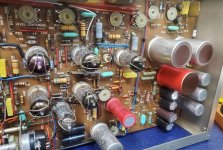Hugo Holden
Veteran Member
Recently there was talk on a thread about the advantages of digital scopes, especially for slow events, because of the memory. I bought up the topic of storage scopes, like the ones Tek made and early types that simply had long persistence phosphors.
I powered up my vintage Telequipment D52 scope, it has a dual long yellow-short blue phosphor (equivalent to the American P7) with an orange filter over it, somewhat similar to those used in vintage ECG units.
I probably have not used it for some years, but my opinion is most equipment should withstand immediate power up, if it doesn't then parts, typically capacitors, need replacing. Though it is probably worth re-forming the giant uF range capacitors used in vintage analog computer supplies. They are getting more difficult to find.
In true style, due to electrically leaky electrolytic capacitors, the D52 spewed out a lot of of smoke. After I replaced some electrolytic caps with 1969 date codes and a cooked up resistor, it was back in business. Probably it should be completely re-capped , but it is somewhat awkward in this unit to remove the main board, so I replaced the defective capacitors from the top without removing the board, fortunately I have some very slim cutters to get under them and cut off their lugs. If I had slowly Variac powered it initially, the defective capacitors might have remained concealed, to cause trouble later. In the past I had to replace the EHT stick rectifiers and the EHT smoothing caps in this scope. You can see the new electrolytic capacitors in the lower right hand corner on the attached photo.
So it is probably fair to say, you have to be prepared to service these old scopes, they might not work every time you switch them on. I don't mind and I have the manuals.
I used the D52 to display a slow signal on a project I am working on, it has a period of about 400mS, swing positive for under half that time and negative the other half with a small gap in between of zero volts.
I have attached a video link. The phone camera makes it look a little more impressive than it is, but still the long persistence phosphor is very helpful:
I powered up my vintage Telequipment D52 scope, it has a dual long yellow-short blue phosphor (equivalent to the American P7) with an orange filter over it, somewhat similar to those used in vintage ECG units.
I probably have not used it for some years, but my opinion is most equipment should withstand immediate power up, if it doesn't then parts, typically capacitors, need replacing. Though it is probably worth re-forming the giant uF range capacitors used in vintage analog computer supplies. They are getting more difficult to find.
In true style, due to electrically leaky electrolytic capacitors, the D52 spewed out a lot of of smoke. After I replaced some electrolytic caps with 1969 date codes and a cooked up resistor, it was back in business. Probably it should be completely re-capped , but it is somewhat awkward in this unit to remove the main board, so I replaced the defective capacitors from the top without removing the board, fortunately I have some very slim cutters to get under them and cut off their lugs. If I had slowly Variac powered it initially, the defective capacitors might have remained concealed, to cause trouble later. In the past I had to replace the EHT stick rectifiers and the EHT smoothing caps in this scope. You can see the new electrolytic capacitors in the lower right hand corner on the attached photo.
So it is probably fair to say, you have to be prepared to service these old scopes, they might not work every time you switch them on. I don't mind and I have the manuals.
I used the D52 to display a slow signal on a project I am working on, it has a period of about 400mS, swing positive for under half that time and negative the other half with a small gap in between of zero volts.
I have attached a video link. The phone camera makes it look a little more impressive than it is, but still the long persistence phosphor is very helpful:

